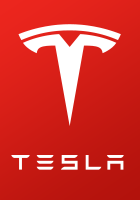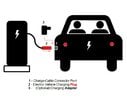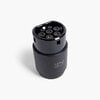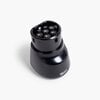Here is a comparative table of the latest (as of 05/27/2022) Tesla charge connectors (with port and some plug illustrations) used in three key market areas within the Tesla car world—mainland China, North America (with Japan and South Korea), and Europe (with Oceania and coastal east-Asia). The charge-equipment standards used for new Tesla cars in those regions are, respectively, (a) Guobiao/Tuijian (GB/T), (b) North America Charging System (NACS) (originally the Tesla Proprietary Charging standard), and (c) Type 2 (Mennekes)/Combined Charging System (CCS) Combo 2.
For further information, this is an illustrated table of International Charging Plugs. In addition, a world-map showing the major Tesla sales areas and corresponding types of charging equipment connectors is here: Charging Equipment of the World. Based on the absence of supercharger and destination charger locations is many areas, future large electric-car markets may include Central and South America, Africa and Madagascar, the Indian sub-continent, and Russia, as well as collectively many other Tesla-poor nations and regions.
NOTES (China)
For further information, this is an illustrated table of International Charging Plugs. In addition, a world-map showing the major Tesla sales areas and corresponding types of charging equipment connectors is here: Charging Equipment of the World. Based on the absence of supercharger and destination charger locations is many areas, future large electric-car markets may include Central and South America, Africa and Madagascar, the Indian sub-continent, and Russia, as well as collectively many other Tesla-poor nations and regions.
NOTES (China)
- The acronym "GB/T" stands for "Guobiao" ("National Standard") and "Tuijian" ("Recommended").
- Note incompatible gender and wiring differences between otherwise similar Chinese and European Type 2 plug ends.
- Older cars:
- Newer cars come equipped with dual GB/T ports. No National Standard adapters are required.
- All model-years (since 2012) use
Tesla Proprietary Connection (TPC)the newly christened "North American Charging System" (NACS) standard of ports, which will eventually accept Tesla and most, if not all, electric car brands sold in NA--both AC and DC fast-charging equipment cable plugs. - As of 2024 the Level 2 J1772 adapter (with NACS plug) is still used at most public AC charging stations and with non-Tesla home/destination charging equipment. However, if most NA charging equipment does indeed adopt the NACS standard, J1772 adapters may in time become obsolete.
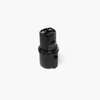
- (As of 2024) Third-party CHAdeMO DC fast-charge stations may still be found in North America.
- Until October 2021 Tesla offered a CHAdeMO adapter with NACS-style plug intended for use with all four models.
- With release of more powerful/faster Tesla and aftermarket CCS1 (in 2022) adapters, and with apparent adoption of the NACS standard, need for CHAdeMO adapters at most charge stations will probably continue to diminish.
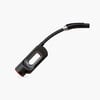
- Third-party CCS1 (CCS Combo 1) DC fast-charge stations (originally used by almost all non-Tesla electric cars in North America) were slowly increasing in number (say up to ~2023). However, adoption of the NACS standard may in years to come eliminate the need for all adapters.
- In 2022 the Tesla CCS1 adapter reached North America initially in an unanticipated manner--via innovative South Korean export businesses (like Harumio) used by "pioneering" TMC customers who bravely imported the supposedly Models 3/Y-only devices to North America, where they were found to successfully work in all model-year vehicles with the CCS function "enabled" (e.g., 2020 to present cars, excluding 06/21-10/21).
- September 21, 2022 Update: Tesla officially released its CCS1 adapter to Canada and the United States:

- Note: Tesla and third-party CCS1 adapters have a circular J1772-like socket at the top. While J1772 cable-plugs may comfortably fit into that socket, the Tesla CCS1 adapter can not normally be used to charge a car with (Level 2) AC charging equipment (w/J1772 plugs). (The circular CCS1 adapter socket lacks certain corresponding connecting pins that are present in the J1772 plug and that are necessary for AC charging.)
- Cars sold in Japan (Models S, X, 3), South Korea (all models), and (previously) Taiwan (S, X, 3) also come/came with Tesla proprietary (now called NACS) ports.
- Tesla CHAdeMO adapters with NACS plugs are sold in South Korea and Taiwan (see below) and may still be available directly from service centers in Japan.
- Despite finding widespread use in North America, the Tesla CCS Combo 1 adapter sold officially only in South Korea (see note above) is still described as being for Models 3 & Y, and for Models S & X from 2023 onward, only.
- In Taiwan Tesla has switched charging standards, again, this time to CCS2 charge-ports for Models S and X (as already found in Model 3). Older cars will continue to get by with Type 2 or even NACS ports (in the oldest vehicles).
- The CHAdeMO adapter with NACS plug is still listed.
- Two types of Tesla Generation 2 Mobile Connectors (for home AC use) are available for cars with (a) CCS2 or Type 2 ports and (b) the original NACS port.
- A (likely) goal of allowing all model-years to use all Supercharger, CCS2, and CHAdeMO sites throughout Europe has not yet been fully achieved. But the level of access is good notwithstanding, especially for certain models.
- According to Tesla, the Supercharger network is (collectively) available to all model-years (Supercharging in Europe). V2 Superchargers now have two cables to accommodate cars with either Type 2 or CCS2 ports. V3 Superchargers each have one CCS2 cable.
- Ultimately, the ability to use specific Supercharger and other DC charging sites still depends on model, age, and hardware/software-status of the car as well as availability of charging adapters (see model-specific notes, below).
- Note incompatible gender and wiring differences between the otherwise similar-appearing European and Chinese Type 2 plugs.
- Models S and X(1/22 and after)
- See Post #20 for updated information.
- New cars will not use CHAdeMO (Type 2 plug) adapters.
- And they cannot connect with DC-power cables with Type 2 plugs.
- They can, however, use AC-power Type 2 plugs.
- Models S and X (before 2022)
- All years came with Type 2 charge-ports (pictured in the Table, above).
- Note subtle modifications to the basic "Mennekes" design in the Model S port pictured below. Only Models S and X were apparently originally intended to use Superchargers.
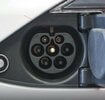
- To use CCS2 equipment, a CCS Combo 2 (CCS2-to-Type 2) adapter is required.
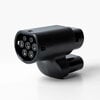
- Cars made before May 2019 also require a hardware retrofit to use Tesla CCS2 adapters. Newer cars do not need such a retrofit.
- A Tesla CHAdeMO adapter (with Type 2 plug) remains available (for Models S & X only). Older vehicles must be Supercharger-enabled (at a Service Center) to accept the CHAdeMO adapter. Newer vehicles come Supercharger-enabled from the factory.
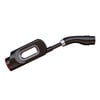
- In summary, all Models S & X (with qualifications) should now be able to charge at:
- V2 Superchargers.
- V3 Superchargers (using a CCS Combo 2 adapter--see note above on whether a hardware retrofit is needed).
- Third-party CCS2 charging stations (using that CCS2 adapter).
- Third-party CHAdeMO stations (using the CHAdeMO adapter--see note above on needing to be Supercharger-enabled).
- Models 3 & Y
- Since November 2018 Models 3 and Y come outfitted with CCS Combo 2 inlet-ports (pictured in the Table, above).
- Models 3 & Y outfitted with CCS2 ports should be able to charge at:
- V2 Superchargers (which have been retrofitted with CCS2 charging cables).
- V3 Superchargers.
- Third-party CCS2 charging stations.
- Sadly, these cars cannot use Supercharger cables with Type 2 plugs.
- And they cannot use Tesla CHAdeMO adapters.
- Other areas that use European-style charge connectors include New Zealand, Australia, Macao, Hong Kong, and (now) Taiwan.
- In Australia and New Zealand (part of Oceania) Tesla sells Models S, X, and 3.
- Supercharger characteristics are similar to those in Europe.
- V2 Superchargers now have CCS2 and Type 2 (modified) charge cables.
- Proprietary Supercharger Type 2 plugs have that extra "key" that prevents entry into non-Tesla car (Type 2) ports.
- V3 Superchargers have CCS2 cables only. - I assume that Models S & X will start to be outfitted with CCS2 charge-ports, like Model 3.
- A Tesla CCS Combo 2 adapter (CCS2-to-Type 2) is available for older cars.
- As is a Tesla CHAdeMO adapter (with Type 2 plug). - Model 3 comes with the CCS2 port (Tesla Charging in Australia).
- These cars require no adapter to use CCS2 Supercharger and third-party charging stations.
- But are unable to use the Tesla CHAdeMO DC adapter or Supercharger Type 2 cables.
- Supercharger characteristics are similar to those in Europe.
- In Hong Kong and Macao Tesla sells the GB/T-to-Type 2 AC adapter (see Mainland China notes) on its websites.
- See also information about Taiwan under "NOTES (North America)," above. Models S and X now come outfitted with CCS2 ports.
- In Australia and New Zealand (part of Oceania) Tesla sells Models S, X, and 3.
- Charge-plug-end illustrations are not to scale.
- The (4-color) charge-plug illustrations (derived from Wikipedia sources) are intended to reveal:
- The full range of possible connection-circuit functions, and
- internal and external differences among regional equipment.
- Individual circuit pathways may or may not be active or even present depending on whether a plug is intended for AC or DC loads.
- We know that charging a Tesla car from one region (say North America) in another region (Europe, for example) may be possible.
- But research, planning, and preparation should be undertaken before taking a car from one region to another.
- Despite that, not all charging options (e.g., Supercharging) may initially be readily available.
- Aftermarket adapters may be available to increase charging opportunities in the region to be visited. Such 3rd-party adapters may lack Tesla emergency-current-disconnect safeguards, however. Use appropriate caution when selecting and employing non-Tesla charging accessories.
- Also, we are told that not all vehicle features, like Navigation, may function properly in a new region.
- So if you plan to take a car from one region to another, investigate carefully and thoroughly beforehand.
- See Charging Equipment of the World for a map showing where various types of charging equipment are used in the different countries.
- Sources included Wikipedia, Electrek, Teslarati, Reddit, and the TMC.
Last edited:

